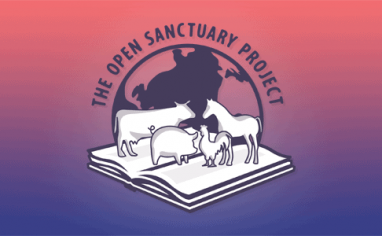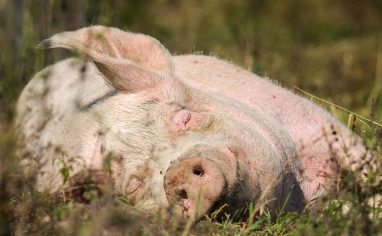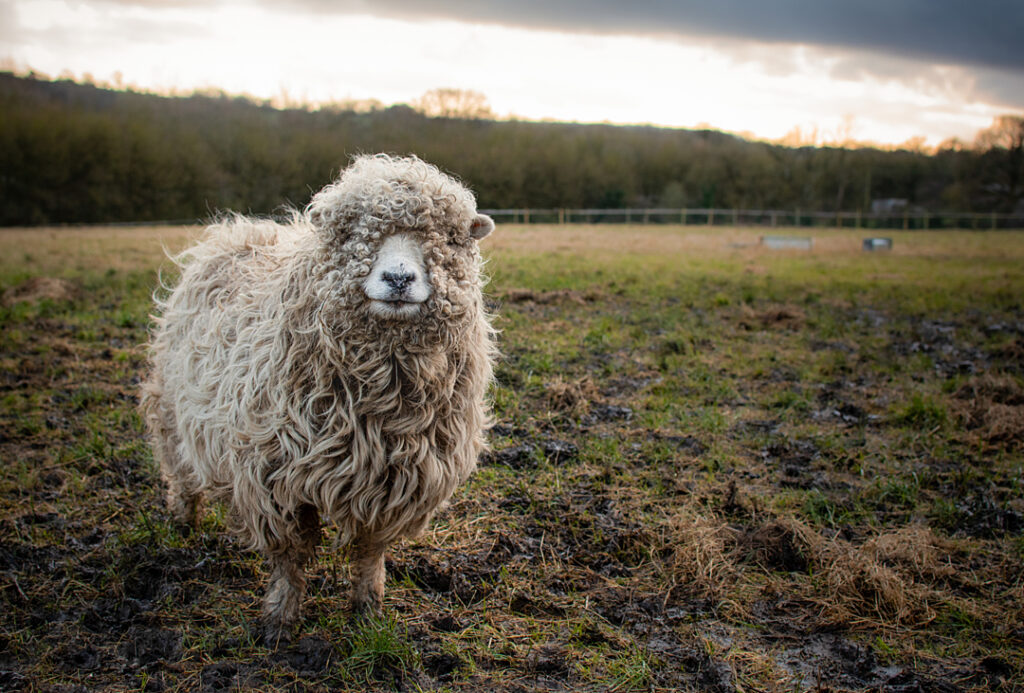
Check Out Our Courses On Basic Sheep And Goat Care!
The following is an excerpt from Basic Sheep And Goat Care Part 2, one of the free course offerings available at our Compassionate Care Classroom. We hope you’ll check out the course, but given the important role the following concepts play in working with sheep and goats, we want to ensure this information is easily accessible to anyone looking for it by offering this stand-alone resource.
When caring for sheep and goats, it’s important to understand the concept of the flight and pressure zone. This is the imaginary space around an individual that is essentially their personal space. Entering this space will make the individual feel uncomfortable or even threatened, depending on the circumstance, and will cause them to move away from you. The size of an individual’s flight and pressure zone will vary based on things like their comfort level around humans, past experiences, and personality. It can also change in size depending on their surroundings, the situation, and how they are being approached. We’ll take a closer look at some of these factors next.
Recognizing that each individual will have their own flight zone that will vary in size depending on the circumstances, let’s consider the flight and pressure zone of sheep and goats more generally, which is represented in the graphic below.
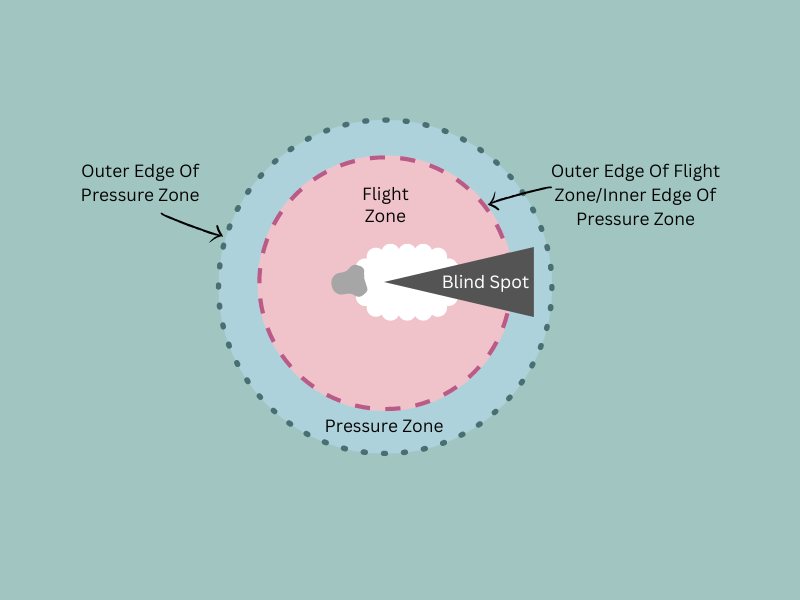
Here, you can see the sheep (representing either a sheep or a goat) is surrounded by a pink circle (representing their flight zone) and a larger blue circle (representing their pressure zone). Typically, when you enter an individual’s pressure zone, they will turn to face you and will move as needed in order to maintain a safe distance from you. Individuals who are very comfortable with their caregivers may not have a noticeable pressure zone in certain situations (and may very well seek you out when you enter their living spaceThe indoor or outdoor area where an animal resident lives, eats, and rests.). Individuals who are less comfortable with human presence may have a very large pressure zone – sometimes encompassing their entire indoor space. Other sheep and goats will fall somewhere in between these two ends of the spectrum.
When you move beyond an individual’s pressure zone and into their flight zone, they will turn and move away from you. Typically, the further into their flight zone you get, the faster they will move away from you. Moving deep into the flight zone can cause the individual to panic and run (or even jump if something is blocking their path). As noted previously, because sheep, and to a lesser extent goats, tend to move as a group and tend to flee when they feel threatened, encroaching on the flight zone of one resident can cause the entire group to flee.
Though sheep and goats have excellent peripheral vision, they have a blind spot directly behind them. As prey animals, small ruminants need to stay vigilant about approaching predators, so if they sense you in their blind spot, they will typically reposition themselves so they can see you.
Factors That Can Affect The Size Of An Individual’s Flight Zone
As mentioned earlier, each resident will have their own flight zone, and there may be a significant difference in the size of different residents’ flight zones. Additionally, the size of an individual’s flight zone can change depending on the situation. Factors that can affect the size of a resident’s flight zone include the following:
Comfort With Humans, Generally
Individuals who are nervous around humans will typically have a larger flight zone than individuals who are comfortable with human presence. Individuals who have lived feral or in settings where they did not have many interactions with humans will typically have a large flight zone, but this may shrink over time as they become more accustomed to human presence. Frequent positive or neutral human interactions can help “shrink” an individual’s flight zone, but this can take time.
Comfort With The Specific Human(s) Approaching Them
Some individuals may be comfortable with certain humans approaching them, but not others. Perhaps this manifests as their flight zone being smaller when a human they know is approaching them versus someone they are unfamiliar with. Or, perhaps they are mostly comfortable with humans approaching them, whether they know them or not, with the exception of the vet or shearer. Because they may associate negative experiences with these individuals, they might have a larger flight zone when these folks are around. It’s also possible that an individual might be comfortable with each of their caregivers approaching them individually, but if two or more caregivers approach them, they are not (again, perhaps because of negative associations with being approached by multiple people at once).
Personality/Temperament
While an individual’s past experiences with humans do have an impact on their comfort around humans, it’s also important to recognize that each sheep and goat is an individual with their own personality and temperament. Some individuals may be naturally bolder or more reserved than others, impacting the size of their flight zone.
Social Relationships
Particularly with sheep, it’s common for an individual’s flight zone to increase in size if they are away from or fully isolated from their social group. Because they are flock/herd animals, fully isolating a small ruminant should be avoided whenever possible.
The Space They’re In
As prey animals, sheep and goats will often have a bigger flight zone when in a large, wide-open space and a smaller flight zone when in a smaller, enclosed space. Therefore, you may find that your residents respond to your presence differently when they are indoors than when they are in large outdoor spaces.
The Presence Of Known Objects
The size of a resident’s flight zone can also be affected by the presence of known objects (objects they recognize). This may be something that you are carrying with you or something that has been brought into or near their space. The associations they have with these objects – positive, negative, or neutral – will determine what, if any, impact the presence of these objects has on the size of their flight zone. A positive object may shrink their flight zone, a negative object might expand it, and a neutral object may have no impact. If, for example, you enter their space carrying a bucket containing berries that you use to conceal pain medication, you may find that individuals who associate the bucket with a tasty treat have no noticeable flight zone and may come running to greet you. If, on the other hand, you are carrying a halter in preparation for health checks, you may find that some or all of the residents appear a bit more wary if they have negative associations with the halter. Carrying an object that is familiar but neutral (perhaps a bucket and brush used to clean water units) may have no noticeable impact on the size of their flight zone.
The Presence Of Unknown Objects
Particularly with sheep, the presence of an unknown object may elicit uncertainty or even fear, which could cause their flight zone to expand. However, everyone is different; for some individuals, an unfamiliar object may elicit curiosity and have little or no impact on their flight zone.
Time Of Day
Sheep and goats quickly learn the daily routine, and when they anticipate something negative (such as a daily health treatment they don’t enjoy), they might have a noticeably larger flight zone than at other times of the day.
Current Stress Levels
When individuals are stressed, their flight zone is typically larger. If an individual (or the group generally) is stressed or fearful, returning to a calmer state will take a while. Individuals may be stressed for various reasons such as a loud noise, unhealthy group dynamics, being startled by someone approaching them quickly or in their blind spot, or by a recent negative experience.
Negative Associations
Many of the above factors that can increase an individual’s flight zone stem from negative associations. A resident who came from an abusive situation prior to rescue may have a large flight zone due to negative associations with humans generally. Or maybe they only have negative associations with men… or men in hats… and so on. Negative associations don’t just apply to residents who come from abusive situations. Certain necessary healthcare tasks might result in negative associations (though there are things you can do to try to avoid this). For example, if the same caregiverSomeone who provides daily care, specifically for animal residents at an animal sanctuary, shelter, or rescue. has to administer an injectable treatment to a particular resident for a week straight, the resident might have a larger flight zone when that particular caregiver is around them than when a different caregiver is around.
How They Are Approached
In addition to the above, how they are approached can also affect the size of an individual’s flight zone. A small ruminant’s flight zone typically extends further in front of them than to their sides. While some residents who are comfortable with your presence may not mind if you approach them head-on, for other residents, doing this may cause their flight zone to expand. The speed and manner in which you approach also have an impact. Approaching a sheep or goat in a loud, fast, or frenzied manner (as opposed to slowly, quietly, and calmly) will likely cause their flight zone to expand. Additionally, entering their blind spot will typically cause their flight zone to expand.
While each individual will have their own flight zone and factors beyond our control will impact its size (for example, their past experiences or personality), it’s important to recognize that there are also factors within our control that affect a resident’s flight zone. We can help shrink an individual’s flight zone by striving to keep human-resident interactions positive or neutral as much as possible. For those care-related activities that they may find negative, it’s important to find ways to keep them as stress-free and comfortable as possible. Depending on the individual and their background, it may take quite a bit of time and patience to get them comfortable with human presence and touch. Don’t rush it – that will only make matters worse! In the meantime, be thoughtful about how you (and anyone else) interact with them so as not to inadvertently reinforce past negative experiences.
Point Of Balance
You already know that entering a resident’s flight zone will cause them to move away from you, but let’s consider what that looks like.
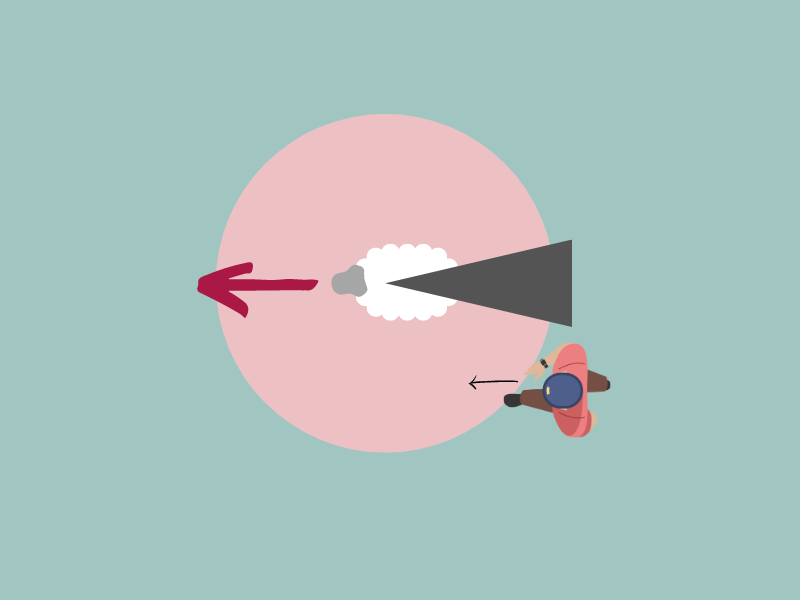
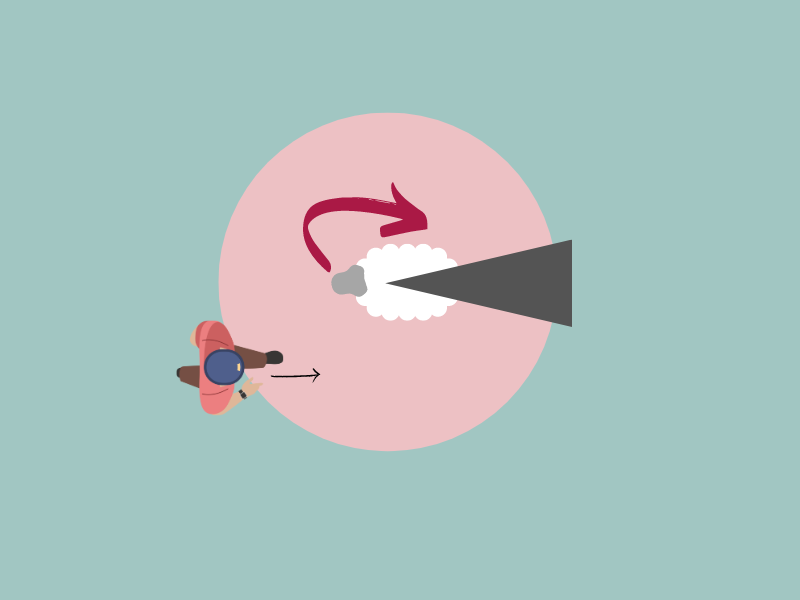
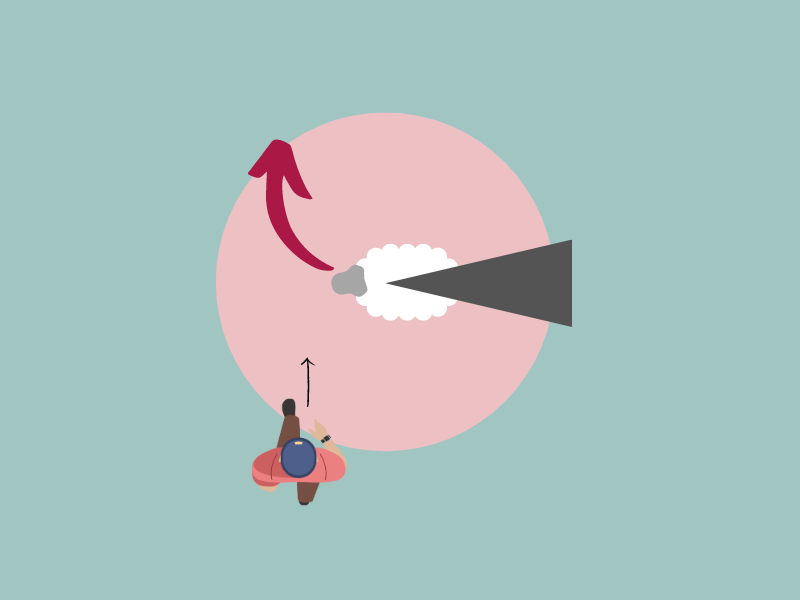
While you can typically anticipate that a resident will move away from you when you enter their flight zone, the direction they move in will depend on where you are in relation to their point of balance. This is an imaginary line that runs across a small ruminant’s shoulders and extends out to the sides, as shown in the graphic below.
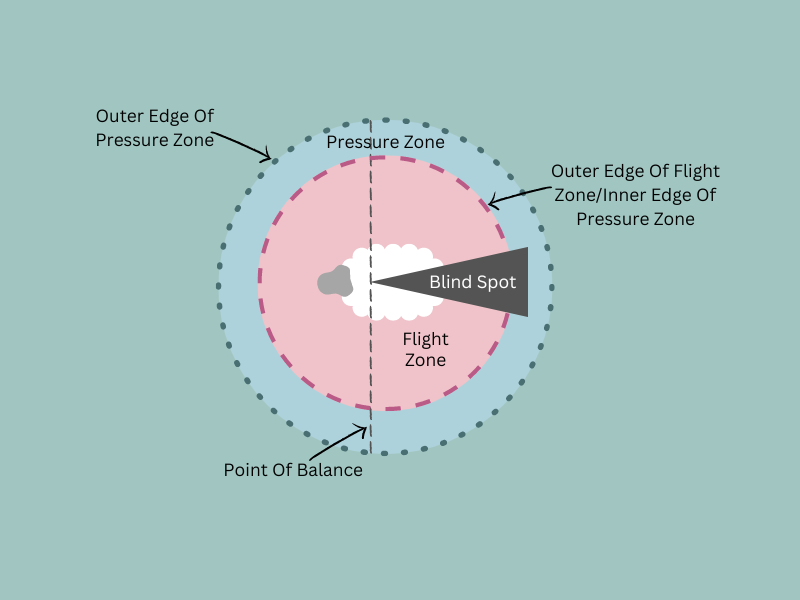
An individual will move away from you when you enter their flight zone (as depicted in the graphics above), but moving across their point of balance will cause them to move in the opposite direction. This is important to understand. If you need a resident to move forward, calmly entering their flight zone from behind them (but not in their blind spot) should encourage this movement. However, if you move across their point of balance, they will stop moving forward and may either take steps backward or turn around and move in the opposite direction, as shown in the graphic below.
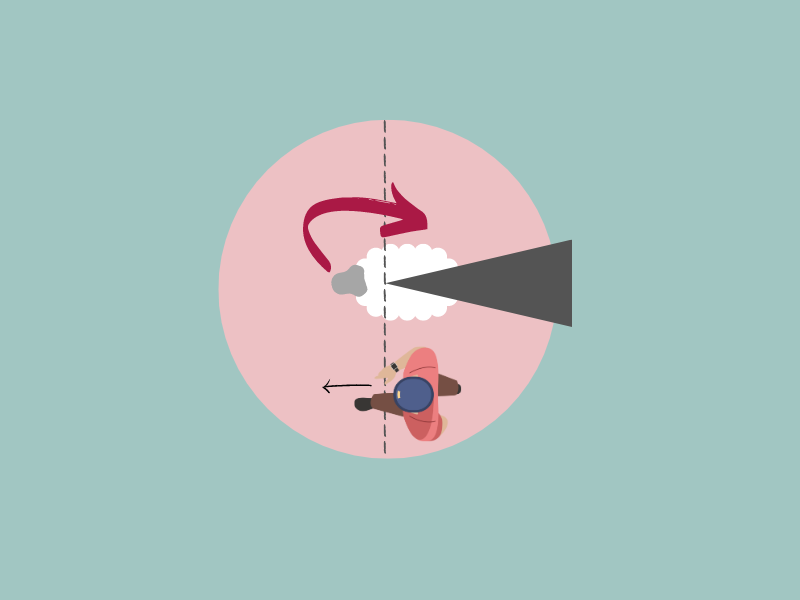
When considering the direction a resident will move, it’s not just about where you are standing. You also have to consider where other humans are in relation to them. Using the same example as above, if you need a resident to move forward and are careful to stay behind their point of balance, you should be able to encourage them to continue moving forward. However, if another human is standing in front of their point of balance, the individual will typically refuse to move forward. If they have room to turn and move away from both of you, they will. If they do not, they will usually stop moving.

The main point to remember is that a sheep or goat (or group of residents) is unlikely to move forward if humans are standing in front of them. So, if you are trying to walk someone into a pen, having a helper stand at the entrance of the pen or inside the pen is most likely going to result in the individual(s) changing course as they approach the pen. A better use of a helper would be to have them calmly walk behind and on the other side of the individual, as shown below.
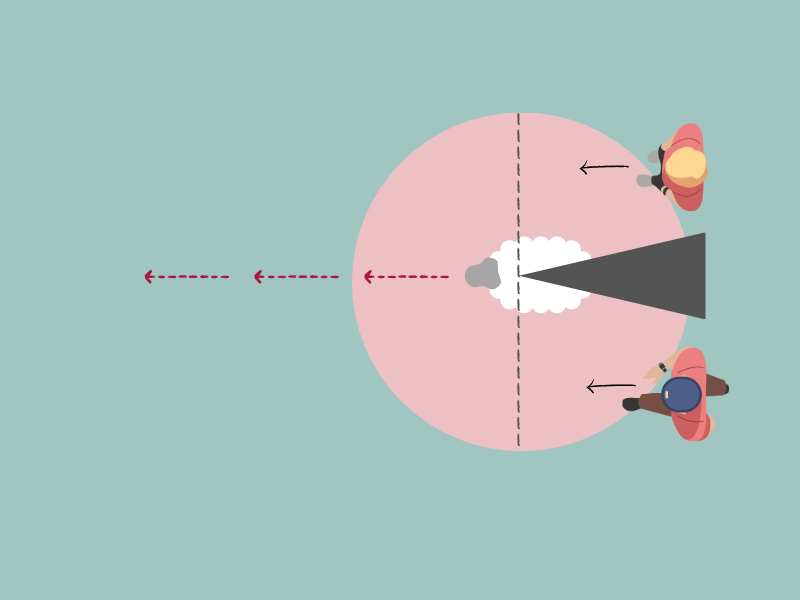
By understanding point of balance, you can be strategic about where you position yourself in relation to a resident so that you can encourage them to move in a certain direction, which is necessary when trying to guide an individual into a corner or other confined space in preparation to restrain them.
SOURCES:
Sheep And Goat Medicine, Second Edition | D.G. Pugh And A.N. Baird (Non-Compassionate Source)
Sheep Behavior | Sheep 201 (Non-Compassionate Source)
The Behaviour Of Sheep And Goats | C. Dwyer (Non-Compassionate Source)
Handling | Maryland Small Ruminant Page (Non-Compassionate Source)
Non-Compassionate Source?
If a source includes the (Non-Compassionate Source) tag, it means that we do not endorse that particular source’s views about animals, even if some of their insights are valuable from a care perspective. See a more detailed explanation here.





